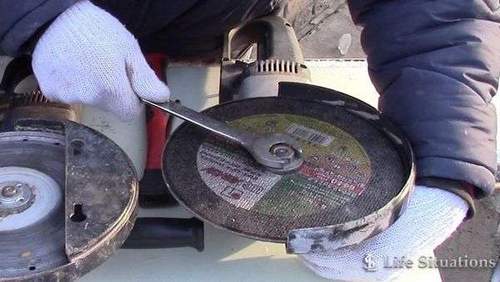How to Unscrew a Tightened Nut on an Angle Grinder
Angle grinder, or angle grinder. A universal tool with which you can perform a wide range of actions. It has a simple mechanism of action, built on the rotation of the shaft by an electric motor. It is necessary for cutting metal parts, polishing surfaces and grinding various materials. One of the common problems during operation of an angle grinder is biting the nut that holds the disc. This does not allow replacing the nozzle, and with strong impact it is possible to damage its thread, break the key or break the case.
Reasons for biting
Typically, this problem occurs on an angle grinder with a diameter of the working surface in the range of 150-180 mm. When strong torque occurs, the disc bites. This leads to the fact that the nozzle cannot be removed using a conventional key, even with the application of serious physical effort.
The second common reason is the use of a disk for an angle grinder, which does not correspond to the factory parameters of the tool. This leads to disruption of the operation of the entire mechanism and jamming. In rare cases, the nut does not lend itself to loosening when rust appears on its thread. Most often this occurs with prolonged use of the tool or storage without changing the nozzle.
Important! Discs for angle grinder are available in standard sizes, the diameter varies from 115 to 230 mm. The landing shaft itself is produced with a diameter of 22.2 mm, when using old models, an adapter is required.
How to unscrew if tightened?
To begin with, we will answer a common question: “In which direction does the nut turn on the angle grinder?”
Remember! Unscrew in the direction of rotation of the disk. Those. If the disk rotates clockwise, then you need to unscrew the nut clockwise.
The easiest way to unscrew the disk mount is to put the key in, and then hit the hammer several times with medium force.

If this does not help, there are alternative methods to solve the problem:
How to Unscrew a Tightened Nut on an Angle Grinder
- Warm up the fastening mechanism with a burner, which will lead to the expansion of the metal. As a result, the structure will become mobile;
- Using a small metal plate, grind the disc all the way to the nut. Continue to grind until its surface comes into contact with the nut and begins to twist it;
- Insert the steel pipe into the holes of the nut, use it as a lever to unscrew the tightened nut. Do not apply too much force so as not to break the thread;
- Grease threads with machine oil, e.G. Wd-40. Wait 3-5 minutes, and then try to unscrew the mount using the key. Using this method, you can get rid of rust inside the bore shaft;
- If you want to remove a circle that has not been used for a long time, you can start to tighten the fasteners even more. After that, try again to weaken it;
- Boiled or rusted threads on an angle grinder can be treated with turpentine, vinegar, white spirit or a rust solvent. After processing, wait at least 30 minutes, and then try again to unscrew the nut.
If a situation arose when you were left without a key, you can cut off the stuck mount with a chisel or grind its second angle grinder with a disk for working with metal. After this, you will have to restore the thread, and also look for a spare nut. If the circle still does not lend itself, you can try to combine different methods. For example, treat the shaft with machine oil, and then begin to unscrew the nozzle using a lever or tap the mechanism with a hammer.
Important! Do not unscrew the mount with great force. This can lead not only to a breakdown of the thread, but also to a breakdown of the case itself, an angle grinder.
How to avoid snacking?
To avoid trouble during the change of nozzle, an angle grinder, it is recommended to prepare for work in advance. To do this, you can insert a small gasket between the disk and the nut. The material is suitable cardboard, a piece of linoleum or plastic.
If the fastener is constantly tightened too much, it is advisable to use a circle of smaller diameter. It is also important to monitor the cleanliness of the tool, timely process the thread with oil, WD-40.
Conclusions
Angle grinder is a simple and useful tool for home or professional use. The most common problem while working with him is biting the nut that holds the disc. It is possible to cope with this with the help of mechanical effects on the mechanism (impacts on the fastener, use of the lever and grinding of the disc), or by chemical means. Treating threads with oil or rust solvent.